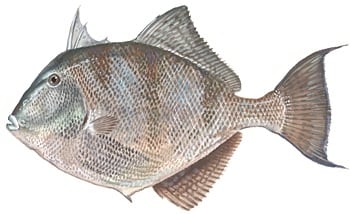KEY MESSAGE:
NOAA Fisheries announces new management measures to rebuild the gray triggerfish stock in the Gulf of Mexico (Gulf), which is currently overfished (stock abundance is too low). The actions will modify the recreational fixed closed season, reduce the recreational bag limit, increase the recreational minimum size limit, and increase the commercial trip limit. The new regulations will be effective on January 16, 2018.
SUMMARY OF PROPOSED CHANGES:
- The current established recreational annual catch limit of 241,200 pounds (1b) whole weight (ww) and annual catch target (quota) of 217,100 lb ww and the commercial annual catch limit of 64,100 lb ww and annual catch target (quota) of 60,900 lb ww will not change.
- For recreational fishermen:
- In addition to the current recreational fixed closed season of June 1 through July 31, an additional recreational fixed closed season of January 1 through the end of February will be in place.
- The recreational bag limit will be 1 gray triggerfish per angler per day within the 20-reef fish aggregate bag limit.
- The recreational minimum size limit will be 15 inches fork length.
- For commercial fishermen:
- The commercial trip limit will be 16 gray triggerfish per trip.
- These measures are expected to rebuild the gray triggerfish population in 9 years, or by the end of 2025.
FORMAL FEDERAL REGISTER NAME/NUMBER: NOAA-NMFS-2017-0080, published December 15, 2017.
FREQUENTLY ASKED QUESTIONS (FAQs)
Why are the new rules necessary?
- A population assessment for Gulf gray triggerfish indicated that the gray triggerfish stock is no longer undergoing overfishing (rate of removal is not too high), but the stock remains overfished (stock abundance is too low).
- NOAA Fisheries notified the Gulf of Mexico Fishery Management Council (Council) that the gray triggerfish stock was not making adequate progress toward rebuilding as required by the Magnuson-Stevens Fishery Conservation and Management Act.
- Within 2 years of the notice, the Council must prepare and implement a plan to rebuild the stock as quickly as possible, but not to exceed 10 years.
Why are changes being made to decrease harvest for the recreational sector, but the commercial trip limit is increasing?
- The recreational sector has exceeded its annual catch limit in recent years, whereas commercial landings of gray triggerfish have been below the commercial quota for the past 3 years.
- The recreational management changes will help prevent the recreational sector from exceeding their annual catch limit, and should allow for harvest later in the year.
- Gray triggerfish are primarily landed by recreational anglers, and the current allocation is 79% recreational and 21% commercial. Therefore, modifications to the recreational sector will have a greater overall impact on rebuilding the population.
- A commercial trip limit increase will allow the commercial sector to achieve optimum harvest while still making progress to rebuild the population.
Where can I find more information?
- Amendment 46, which establishes the new management measures, may be found online at the NOAA Fisheries Southeast Regional Office Web site at: http://sero.nmfs.noaa.gov/sustainable_fisheries/gulf_fisheries/reef_fish/2017/am46_gray_trigger/index.html.
- Contact NOAA Fisheries, Southeast Regional Office
By Mail: Lauren Waters
NOAA Fisheries, Southeast Regional Office
Sustainable Fisheries Division
263 13th Avenue South
St. Petersburg, Florida 33701-5505
By FAX: (727) 824-5308
By Phone: (727) 824-5305





